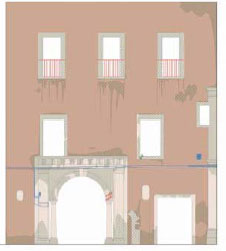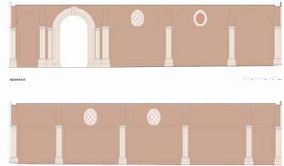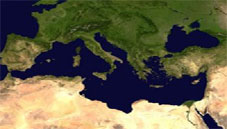At the end of sixteen century, the bishop Giovanni Torres adds a new construction. As illustrated in (a), the enclave is transformed in the “noble court”, reserving to the ancient court the role of collecting the facilities (wealth, malt and olive oil storage, horse boxes, jail, typography…). The two courts of interest are connected by a very narrow passage.
The new system of building survived the 1693 seismic event, but the new bell-tower failure afflicted many portions of it. A notary act of March 25, 1745, covering the reconstruction activity, describes the enlargement of the passage linking the two courts, in such a way that the transit of the limousines was allowed.
As (b) shows, columns were added along the passage, some in Egyptian granite, dating back to the Roman period, found in the site named “San Ippolito”, two in white marble at the beginning and two in granite at the rear court.
In 1762, the architect Dumontier designs a vertical expansion of the “Quarto Torres”. Only a few decades later, it starts to manifest signs of deterioration. Counteractions were attempted in the decade 1780-90 by topical arrangements. But a wider action on the whole construction was required. In 1790, the architect Bertomagi consolidated the foundations with 10 stone pilasters.
During the war air campaign of 1943 on the town of Syracuse, the “Palazzo” was damaged in two areas: “Quarto Torres” and a house named “Ferrini”.
|



|
|



